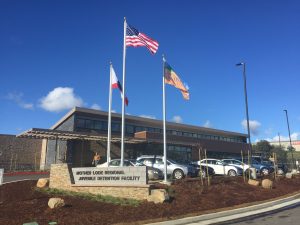Juvenile Hall Update Elicits Support, Some Criticism
Sonora, CA — A year and a week to the day following the opening of the Mother Lode Regional Juvenile Detention Facility, its staff provided local officials with a report on operations to date.
Chief Probation Officer Linda Downey led off yesterday’s presentation in front of the Tuolumne County Board of Supervisors meeting, sharing staff’s common presentation and operations theme: healthy families make for safe communities. The subsequent information indeed, noted that the center’s programming and services, while focused on the youth, takes somewhat of a holistic approach; involving family members’ participation to the greatest extent possible and connecting all involved with a network of substantial, still evolving community support resources.
Through the center’s behavioral health program, juveniles receive suicide risk screenings and individualized treatment addressing key areas such as traumatic and adverse childhood experiences, which studies link to criminogenic risk factors; how to think more morally and responsibly; safety and harm reduction planning that includes dealing with substance abuse triggers; coping and other specific skills towards resilience building; reestablishing connections with immediate and extended family members.
Some General Stats To Date
Since January this year the center has had 66 bookings; including 51 from Tuolumne County; six from Calaveras; and three each from Amador and Mariposa counties along with courtesy holds from San Joaquin, Stanislaus and Santa Barbara counties. Signed formal memo of understanding (MOUs) agreements are in place for accepting juveniles from Amador, Calaveras, Mariposa and Inyo counties. For more operational statistics, provided to Clarke Broadcasting back in February, click here.
Education-wise, officials report the onsite alternative ed program to date has had 52 unique enrollees and maintains a 98 percent attendance rate, operating under a year round schedule. The education budget, partially funded using the ADA formula with just over 50 students, seven of them current, is about $175,000 annually. The center, working closely with Columbia College and the local school districts, helps facilitate CTE career path learning and dual enrollment learning opportunities that often lead to skills certifications.
Downey emphasized both appreciation and gratitude for all the community partnerships that have led to numerous additional program and activity offerings. Among these are 4H-added chicken raising in a coop provided by the sheriff’s office and visits from local law enforcement during “Lunch With A Cop” dates; church and mentoring services; a self-leadership program from the Center For A Nonviolent Community.
A Proactive Positive Difference
Facility Superintendent Mike Arndt emphasized that the center and its treatment and education-based approach is geared for the incarcerated youth, many who were arrested for drugs and/or violent acts and come from fragmented and traumatic backgrounds. Left untreated, he says most are destined to become a complete detriment to the community as well as themselves. Lacking self-sufficiency and the ability to take good care of themselves they become prime candidates for homelessness; victimizing others as adults and developing an over-reliance on government services.
With Supervisor and Board Chair John Gray absent from the meeting, the remaining four supervisors piped up with their thoughts. Supervisor and Vice Chair Evan Royce, before using his gavel to signal the discussion’s end, opined along with one public dissenter that the county has millions in tough budget cuts ahead, as reported here. As an opponent of the center to begin with, Royce signaled he will be throwing his support to library, rec and pool programs that would locally serve many more kids over providing the smaller juvenile offender population with assistance funding from the county.
Ahead of that however, supervisors Sherri Brennan, Randy Hanvelt and Karl Rodefer, while acknowledging the budget challenges, weighed in with supportive comments that were also reflected in the rest of the public comments made at the end of the presentation.
All things considered, Rodefer pointed out that costs rack up quickly when juveniles have to be transported, lodged and dealt with when they are housed outside the area and then program controls are lost. Hanvelt opined that besides wanting to see positive outcomes, it makes better sense to invest in the county’s juvenile offenders upfront rather than pay to support a non-rehabilitated population of ongoing offenders as well as bear related societal costs down the line.

